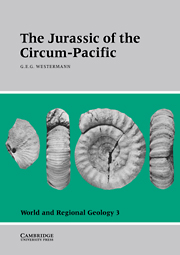Book contents
- Frontmatter
- Contents
- List of contributors
- Preface
- Acknowledgments
- Introduction
- Part I Time scales
- Part II Circum-Pacific base map
- 3 Reconstructions of the circum-Pacific region
- Part III Regional geology and stratigraphy
- Part IV Biochronology
- Part V Biogeography
- Part VI Climatology and oceanography
- Appendix: Biochronology and atlas with index and guide fossils
- General Index
- Index of Guide- and Indexfossils
3 - Reconstructions of the circum-Pacific region
Published online by Cambridge University Press: 04 August 2010
- Frontmatter
- Contents
- List of contributors
- Preface
- Acknowledgments
- Introduction
- Part I Time scales
- Part II Circum-Pacific base map
- 3 Reconstructions of the circum-Pacific region
- Part III Regional geology and stratigraphy
- Part IV Biochronology
- Part V Biogeography
- Part VI Climatology and oceanography
- Appendix: Biochronology and atlas with index and guide fossils
- General Index
- Index of Guide- and Indexfossils
Summary
Introduction
This chapter attempts a simplified paleogeographic assessment of the major allochtonous elements important to the Jurassic of the circum-Pacific region. Sketch reconstructions of the Pliensbachian (∼190 Ma), Bathonian (∼165 Ma), and Tithonian (∼140 Ma) stages are presented. The reconstructions are extremely simplified, in part reflecting the scale of the maps, and in part reflecting a limited understanding of the detailed relationships between the various tectonic elements, the so-called terranes (Coney, Jones, and Monger 1980), that comprise the tectonic collage that characterizes circum-Pacific and Asian regions. A conservative approach has been followed, and on the average only limited motion (on the order of hundreds to thousands of kilometers) between the larger tectonic elements (sometimes referred to as superterranes) has been inferred. No attempt has been made to reconstruct the central Pacific Ocean basin or the plate motions associated with the evolution of the Pacific, Phoenix, Farallon, Kula, Izanagi I, and Izanagi II plates, which have been summarized elsewhere by Hilde, Uyeda, and Kronke (1977), Engebretson, Cox, and Gordon (1984, 1985), and Henderson, Gordon, and Engebretson (1984), among others. The summary presented here depends heavily on our compilation of a Mesozoic and Cenozoic tectonic map of the world (Rowley et al. 1985) as part of the Paleogeographic Atlas Project, as well as on syntheses by Davis, Monger, and Burchfiel (1978), Dickinson (1981), and Hamilton (1978) for the western United States, Monger, Price, and Templeman-Kluit (1982), Monger et al. (1985),
- Type
- Chapter
- Information
- The Jurassic of the Circum-Pacific , pp. 15 - 28Publisher: Cambridge University PressPrint publication year: 1993
- 2
- Cited by



